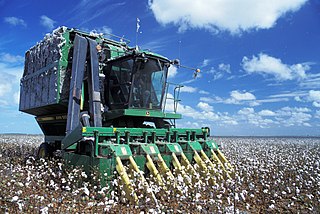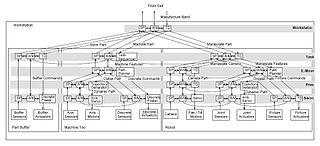
Automation describes a wide range of technologies that reduce human intervention in processes, namely by predetermining decision criteria, subprocess relationships, and related actions, as well as embodying those predeterminations in machines. Automation has been achieved by various means including mechanical, hydraulic, pneumatic, electrical, electronic devices, and computers, usually in combination. Complicated systems, such as modern factories, airplanes, and ships typically use combinations of all of these techniques. The benefit of automation includes labor savings, reducing waste, savings in electricity costs, savings in material costs, and improvements to quality, accuracy, and precision.

ABB Ltd. is a Swedish-Swiss multinational corporation headquartered in Zürich, Switzerland. The company was formed in 1988 when Sweden's Allmänna Svenska Elektriska Aktiebolaget (ASEA) and Switzerland's Brown, Boveri & Cie merged to create ASEA Brown Boveri, later simplified to the initials ABB. Both companies were established in the late 1800s and were major electrical equipment manufacturers, a business that ABB remains active in today. The company has also since expanded to robotics and automation technology.

Mechatronics engineering also called mechatronics, is an interdisciplinary branch of engineering that focuses on the integration of mechanical, electrical and electronic engineering systems, and also includes a combination of robotics, electronics, computer science, telecommunications, systems, control, and product engineering.
Business process automation (BPA), also known as business automation or digital transformation, is the technology-enabled automation of complex business processes. It can streamline a business for simplicity, achieve digital transformation, increase service quality, improve service delivery or contain costs. It consists of integrating applications, restructuring labor resources and using software applications throughout the organization. Robotic process automation is an emerging field within BPA.

FANUC is a Japanese group of companies that provide automation products and services such as robotics and computer numerical control wireless systems. These companies are principally FANUC Corporation of Japan, Fanuc America Corporation of Rochester Hills, Michigan, USA, and FANUC Europe Corporation S.A. of Luxembourg.

Computer-integrated manufacturing (CIM) is the manufacturing approach of using computers to control the entire production process. This integration allows individual processes to exchange information with each part. Manufacturing can be faster and less error-prone by the integration of computers. Typically CIM relies on closed-loop control processes based on real-time input from sensors. It is also known as flexible design and manufacturing.

Robot welding is the use of mechanized programmable tools (robots), which completely automate a welding process by both performing the weld and handling the part. Processes such as gas metal arc welding, while often automated, are not necessarily equivalent to robot welding, since a human operator sometimes prepares the materials to be welded. Robot welding is commonly used for resistance spot welding and arc welding in high production applications, such as the automotive industry.
KUKA is a German manufacturer of industrial robots and systems for factory automation. It has been predominantly owned by the Chinese company Midea Group since 2016.

Mechanised agriculture or agricultural mechanization is the use of machinery and equipment, ranging from simple and basic hand tools to more sophisticated, motorized equipment and machinery, to perform agricultural operations. In modern times, powered machinery has replaced many farm task formerly carried out by manual labour or by working animals such as oxen, horses and mules.
Design for assembly (DFA) is a process by which products are designed with ease of assembly in mind. If a product contains fewer parts it will take less time to assemble, thereby reducing assembly costs. In addition, if the parts are provided with features which make it easier to grasp, move, orient and insert them, this will also reduce assembly time and assembly costs. The reduction of the number of parts in an assembly has the added benefit of generally reducing the total cost of parts in the assembly. This is usually where the major cost benefits of the application of design for assembly occur.
Lights-out manufacturing is a manufacturing methodology, not a specific process.
The following outline is provided as an overview of and topical guide to automation:

An agricultural robot is a robot deployed for agricultural purposes. The main area of application of robots in agriculture today is at the harvesting stage. Emerging applications of robots or drones in agriculture include weed control, cloud seeding, planting seeds, harvesting, environmental monitoring and soil analysis. According to Verified Market Research, the agricultural robots market is expected to reach $11.58 billion by 2025.

Manufacturing engineering or production engineering is a branch of professional engineering that shares many common concepts and ideas with other fields of engineering such as mechanical, chemical, electrical, and industrial engineering. Manufacturing engineering requires the ability to plan the practices of manufacturing; to research and to develop tools, processes, machines and equipment; and to integrate the facilities and systems for producing quality products with the optimum expenditure of capital.
The IEEE Robotics and Automation Society is a professional society of the IEEE that supports the development and the exchange of scientific knowledge in the fields of robotics and automation, including applied and theoretical issues.

Real-time Control System (RCS) is a reference model architecture, suitable for many software-intensive, real-time computing control problem domains. It defines the types of functions needed in a real-time intelligent control system, and how these functions relate to each other.
Plant floor communications refers to the control and data communications typically found in automation environments, on a manufacturing plant floor or process plant. The difference between manufacturing and process is typically the types of control involved, discrete control or continuous control. Many plants offer a hybrid of both discrete and continuous control. The underlying commonality between them all is that the automation systems are often an integration of multi-vendor products to form one system. Each vendor product typically offers communication capability for programming, maintaining and collecting data from their products. A properly orchestrated plant floor environment will likely include a variety of communications, some for machine to machine (M2M) communications – to facilitate efficient primary control over the process and some for Machine to Enterprise (M2E) communications – to facilitate connectivity with Business Systems that provide overall reporting, scheduling and inventory management functions.

The Fourth Industrial Revolution, 4IR, or Industry 4.0, conceptualises rapid change to technology, industries, and societal patterns and processes in the 21st century due to increasing interconnectivity and smart automation. The term was popularised in 2015 by Klaus Schwab, the World Economic Forum founder and executive chairman, and has since been used in numerous economic, political, and scientific articles in reference to the current era of emerging high technology. Schwab asserts that the changes seen are more than just improvements to efficiency, but express a significant shift in industrial capitalism.

Factory automation infrastructure describes the process of incorporating automation into the manufacturing process of end/final products.

THK Co., Ltd. is a Japanese company that offers machine elements and modules in the field of mechanical engineering, robotics and automation. The headquarters are in Tokyo. Since it was founded in April 1971, the company has developed into an international company. THK shares have been listed on the Tokyo Stock Exchange's first segment since 2001.












